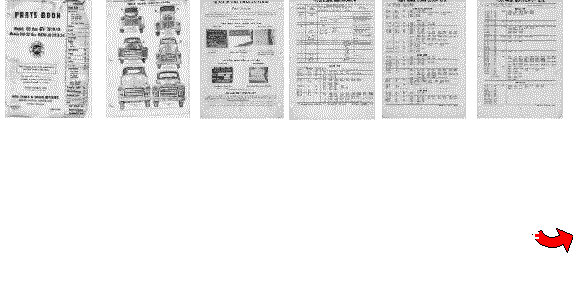International Engine Serial Number Decoder
International Harvester Corporation (now referred to as Navistar International Corporation) manufactures large heavy-duty trucks, tractors, pickups and the Scout SUV. Information about a specific international truck is easily interpreted using a VIN decoder, commonly found on the Internet. It wasn't until 1980 that the National Highway Transportation and Safety Administration (NTSA) created a standard 17-character format to help eliminate ongoing VIN confusion; therefore very limited information is available from International VINs prior to that time.
All of the above models are inline six cylinder diesel engines built on a common platform. The different displacements produced are achieved by bore and stroke variation. ESN location: The complete engine serial number (ESN) is stamped on a pad on the side of the cylinder block. The engine serial number is made up of several components. For example, a full engine serial number could be PJ56P. The engine serial number is the complete number shown. To link to the entire object, paste this link in email, IM or document To embed the entire object, paste this HTML in website To link to this page, paste this link in email, IM or document To embed this page, paste this HTML in website.
Step 1
Locate the VIN. Look for it on the left side of the windshield attached to the dash, the door frame or pillar and on the firewall. It can also be found on the vehicle title.
Step 2
The first character indicates the country where the truck was manufactured. The number 1 is for USA; 2 is for Canada. All Canadian vehicles were manufactured at the plant in Chatham, Ontario.
Step 3
The second character indicates the manufacturer of the vehicle. Ultimate marvel vs capcom 3 exe. H is for International Harvester.
Step 4
The third and fourth characters indicate the type of vehicle and weight rating. Many different models were manufactured. For example, FC was used for the International Scout and FW for the DCO-405 trucks.
Step 5
The fifth, sixth and seventh characters are for vehicle type and body style.
Step 6
The eighth character is used for engine configuration information. There were many sizes and types of engines used for International truck applications. The ninth digit is used as a check digit for VIN verification and authenticity.
Step 7
The 10th character gives the model year information. Meanings for the tenth character are A =1980, B=1981, C=1982, D=1983, E=1984, F=1985, G=1986, H=1987, J=1988, K=1989, L=1990, M=1991, N=1992, P=1993, R=1994, S=1995, T=1996, V=1997, W=1998, X=1999. Y=2000, 1 = 2001, 2=2002, 3=2003, 4=2004, 5=2005, 6=2006, 7=2007, 8=2008, and 9=2009.
Step 8
The 11th digit indicates the plant location. International trucks were built at several different locations. Some of the 11th digit codes are G for Fort Wayne, Indiana; H for Springfield, Illinois; C for Chatham, Ontario; Y for San Leandro, California; and L for Bridgeport, Connecticut.
The last six digits designate the serial number and production sequence of the vehicle.
Items you will need
- Computer access
- Internet VIN decoder
- old truck image by Lars Christensen from Fotolia.com
More Articles
Until the federal government standardized all Vehicle Identification Numbers (VIN) in 1980, motor vehicle companies used their own identification systems. Not only did those systems differ from company to company but also year to year as each organization decided to improve on the conventions they were using.
Some conventions added more information that can be useful today. Other modifications to the identification system might have been useful for the International Harvester Company (IHC) internally but provide little or no value to owners today.
Step 1
Determine the year of your vehicle. Before the standardization of vehicle identification numbers in 1980, each company used its own numbering scheme and IHC was no different. Knowing the year may help you understand the structure of your VIN.
Step 2
Locate the VIN on the engine, using the flashlight if it helps to see the numbers and letters.
Step 3
Using a VIN from prior to 1940, your VIN should reflect IHC's sequence indicating when the company introduced the model followed by the number 501. For example, R100-501, R120-501, R130-501 and so on. When IHC introduced the S and A models in the mid-1950s, they added these letters into the identification sequence. They just continued the numbering with SB even after they introduced the C line in 1961. You should not see the letter C in your VIN though you may see various prefixes to indicate other models such as Scouts (FC) and Emeryville DCO-450s (W).
Step 4
Reading a VIN from 1965 to 1973, you will see a 6-digit model code with a letter to indicate where the vehicle was built followed by a 6-digit serial number. These numbers would indicate the order in which IHC made the vehicles.
Step 5

Taking a VIN from a vehicle produced after 1974 but before 1980, you'll have a five-character model code, then a letter to indicate model year, followed by plant indicator letter, a letter for production line within the plant, and a five digital serial number that started with 10001 at the new year.
Owning a vehicle made in 1980 or later means your VIN will have three characters to indicate the country of origin, manufacturer, and type of vehicle. A 1 indicates United States, 2 is Canada. A number after this is calculated from the other characters to detect alterations to the VIN or errors in computer processing. The next character helped car owners and police determine if anyone had tampered with the VIN. This character represented the year of manufacture, starting with B and skipping I, O, and Z then a number 1 through 9. The sequence restarted in 2010 with the letter A. Again, the last numbers represent's the vehicle's position in the production line.
International Diesel Engine Serial Number Decoder
- truck 1 image by Chad Perry from Fotolia.com